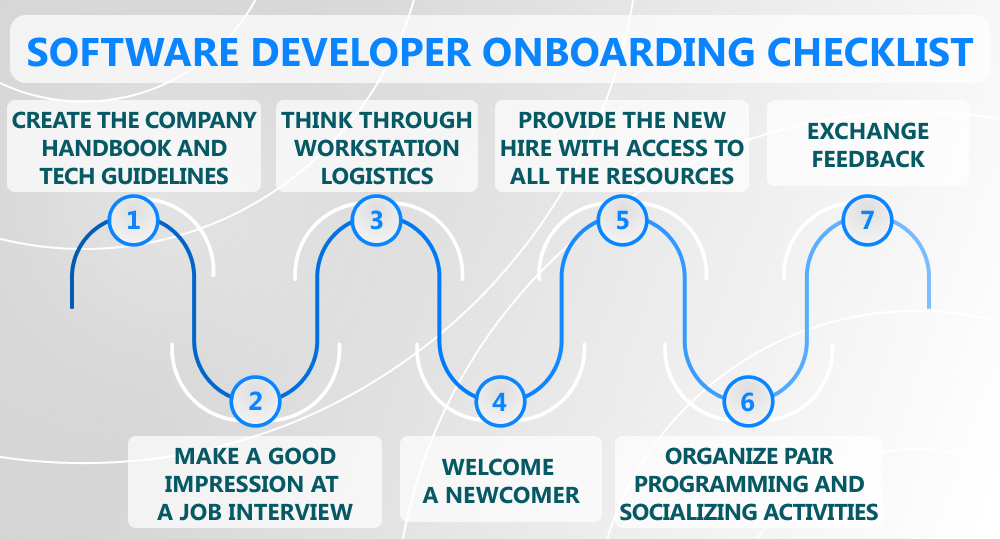Without a software developer onboarding checklist, it's easy to screw the process up and scare off new hires. No wonder 22% of engineers start looking for another job if they were not properly introduced to other team members or the company's rules. The employee onboarding process does work like the acid test, immediately revealing the weak spots of the entire enterprise, that is why, it is so essential to organize it in the best way possible.
In this article, we explain how to avoid unobvious onboarding mistakes and create a pleasant employee experience and result-oriented work environment. Read on!
written by:
Ekaterina Piasetskaya
Senior HR Specialist
Without a software developer onboarding checklist, it's easy to screw the process up and scare off new hires. No wonder 22% of engineers start looking for another job if they were not properly introduced to other team members or the company's rules. The employee onboarding process does work like the acid test, immediately revealing the weak spots of the entire enterprise, that is why, it is so essential to organize it in the best way possible.
Contents
What NOT to Do When Onboarding New Developers
Do you remember your first day at work? Sweaty palms, lots of new faces, awkward small talks, document signing, multiple guidelines… Or maybe you were lucky enough to smoothly plunge into the unknown environment without epic fails or funny stories?
Anyway, when being on the other side of the hiring process and creating a developer onboarding plan, it's always good to recall your own experience as an employee and put yourself in the newcomer's shoes. The analysis of onboarding mistakes may also come in handy and help you better understand the new engineers' expectations, as well as boost retention rates. So let's get started right now and learn how to avoid the major pitfalls.
Mistake#1. Underestimated Hiring Process
Very often, employers forget that onboarding starts way before the first work day and encompasses all the hiring procedures. And although candidates understand that impressions gained at a job interview may be misleading, it doesn't mean you should let it drift.
But don't get us wrong: we don't recommend overloading potential employees with the onboarding package during the interview rounds. We simply suggest you do the utmost to come across as a reliable, successful company with a friendly and highly-productive atmosphere and impactful projects. In this way, not only will the candidate feel excited about a possible offer, but also get the motivation to quicker integrate into the local development environment.
Mistake#2. Accelerated Onboarding
It's hard to believe that some employers consider a step-by-step onboarding plan unnecessary and minimize the process to “Hi! This is our new junior developer. Any questions?”. On the bright side, in the IT field, such a practice is rather the exception, not the rule, but still, the onboarding process remains underestimated and in most cases lasts less than a month.
At the same time, we understand your desire to involve a newcomer in a full range of projects asap. But don't you want to build a long-lasting relationship and decrease the turnover ratio? Just calculate the hiring expenses, and you'll see that they equal or even surpass 2–3 months of developer's work at a low or average pace. It means that sometimes, it's better to set a budget for prolonged onboarding and finally extend the team with a competent employee than waste resources on a vicious hiring circle.
Mistake#3. Lack of Socializing
The onboarding practices have been enhanced significantly over the past decade. Welcoming packages, branded merchandise, memorable team buildings, and colorful events — it all had seemed to be only the beginning of something bigger and even more fascinating. Just until the pandemic knocked on our doors, bringing political and economic instability that still persists.
Today, we have millions of companies with remote workers scattered across the globe that have never seen each other in person. And those enterprises that fail to keep up-to-date and elaborate the system of virtual meetings and team-bonding activities lag behind and lose brilliant developers. Don't want to follow their lead? Pull your socks up, move the onboarding process to the digital space, and foster the team spirit with virtual beer meetings, online game championships, regular meet-ups, and other fun activities.
Mistake#4. Tons of Red Tape on the First Day
When onboarding developers, employers often try to settle all the formalities on the first day, imposing dozens of documents on the newcomers. And according to research by the Human Capital Institute, 58% of organizations are well aware of this mistake but find it insignificant and don't make attempts to avoid it in any way.
Such an approach neither boosts the productivity level nor promotes a better corporate image. Therefore, we strongly recommend you to dedicate a big chunk of the first day to socializing activities and work guidelines and explain the company values and goals to the newcomer.
And yes, paperwork is also essential. But you'd better prioritize the documents and send them to junior developers in several steps during the first few weeks (the major papers should be signed on the first day, and all the others can wait). If you onboard software development teams remotely, take advantage of e-signature tools like PandaDoc, Adobe Sign, or DocuSign.
Mistake#5. Inconsistent or Vague Guidelines
The ability to set precise guidelines and clearly answer questions is the backbone of an effective work process. And today, when there is no opportunity to provide remote junior engineers with offline mentors, it is especially crucial to save and perfect it.
A detailed, well-structured e-handbook with timely updated information may come in handy at this point and help the entire team keep up with any changes and rules. Sure, its creation and maintenance require efforts and resources, but this job will definitely pay off in the long run.
When creating this life-saving guidebook, don't forget to explain to a newcomer how to keep records in project management systems like Jira, Trello, or Assana in compliance with the internal policies, if your company employs them. Besides, include into it the information about all the communication channels used across the enterprise (messengers, video conference tools, etc.), as well as the examples of different types of request letters.
Mistake#6. No Mentor or Pair Buddy
Although a digital handbook is an excellent solution, it's just a complementary tool aimed to simplify, not substitute, the work of mentors.
That is why, when onboarding a new specialist, make sure they have an experienced developer to talk to during one-on-one meetings. Also, don't forget to organize pair programming sessions, as it's a good way to upskill a newcomer and help them understand team workflows.
Pair Programming Types
Interdependent pairing
A new engineer codes under the detailed commands of an experienced mentor and asks questions only after creating the entire piece of code.
Tour guide
A lead creates code and carefully explains and reasons every step. A newcomer analyzes the process and asks questions.
Ping-pong
Perfect for same-level experts. One person writes code, while the other checks and reviews it. And vice versa.
Driver-navigator
One developer creates code, while the other watches the process and gives valuable advice. Later the roles change.
Distributed pairing
Two engineers from different locations, often remote ones, simultaneously work on the same piece of code.
Mistake#7. Last-Minute Workplace Setup
The research by Talmundo & Vlerick Business School reveals that 108 out of 250 newcomers had to wait for over a week to get all the basic equipment and couldn't do their jobs effectively. Such a situation is totally unacceptable if you want to maintain the company's reputation and keep the employee.
To make an impression of a reliable enterprise with well-established processes and meet newcomer expectations, organize a comfortable, fully equipped workspace ready to be employed from day one. And if you deal with a remote specialist, think through workstation logistics in advance.
Mistake#8. Unstandardized Technical Documentation
Although in most companies, the development process unfolds under a similar scenario, the tools and approaches may differ from team to team. To help a newcomer catch up with the others and better understand the workflow, adjust the technical requirements to the common standard and create detailed guidelines on how to set up the local development environment.
And one more piece of advice: while planning onboarding, don't forget to provide new hires with access to company software and internal resources, project documentation and source code, production database, and API keys.
Mistake#9. No Feedback
Keeping track of onboarding successes and failures and discussing them with newcomers during a one-on-one meeting is also a valuable practice. It may help new developers look at their job from the outside perspective and set the right goals.
And it's even more essential to collect feedback and ask employees to evaluate the HR performance, as it allows managers to enhance operational processes. Thus, research by Gallup indicates that only 12% of US remote workers are satisfied with the onboarding they had. Don't you think the number could be much higher if the companies conducted polls and gathered feedback?
Software Developer Onboarding Checklist
Now that you know all the pitfalls by sight, it's time to roll up your sleeves and create a step-by-step onboarding plan. For a starter, you may take our time-tested strategy and simply adjust it to your workflow specifics.
- Before plunging into the hiring activities, pool the efforts around the company handbook and technical guidelines.
- During the job interview, try to come across as a trusted employer and encourage a tech-savvy specialist to accept the offer.
- Once the offer is accepted, discuss workstation logistics with the developer, and send them the first-work-day instructions and the documents that can be already signed (discuss possible e-signing options with remote specialists).
- Ensure a friendly welcome for a newcomer, introduce them to the teammates (in person/chat and with a welcome letter), send the company handbook and branded merchandise, and guide them through the office, if possible.
- Make sure that the employee gets access to all the required resources and technical guidelines, as well as have a mentor or pair buddy.
- Let the new hires sign the rest of the documents throughout the first week, organize pair programming sessions and basic team-building activities, and make sure they get answers to all the questions.
- Conduct one-on-one meetings, either online or offline, to exchange feedback and turn the onboarding period into a pleasant and valuable experience for both parties.
Wanna skip the turmoil of the hiring process and find rock-star developers ready for a smooth, hassle-free collaboration? Contact us, and get well-versed specialists with minimum onboarding efforts.
Additional Insights
In software development, just like in any other field, an onboarding program means a set of practices a company employs to turn a newcomer into a fully-fledged team member. It encompasses organizational, legal, technical, as well as social and team-building procedures.
As a rule, an effective onboarding process consists of 4 stages:
- Preboarding (a period starting right after accepting the offer letter, during which software engineers get all the information regarding the first work day, as well as basic rules, like dress code, normal working hours, etc.);
- Welcoming (the key aim of this phase is to introduce new employees to the entire engineering team and company culture, policies, and communication rules);
- Training (the stage is dedicated to educating new team members, introducing them to technology standards and documentation, as well as showing them the upskilling opportunities and software tutorials provided by a company);
- Transition to the new role (complete integration of the new hire into the company, after which they become fully-fledged team members).
Compliance, connection, culture, clarification, and checking back are five key pillars that make onboarding processes truly successful.
Many HR experts say that the optimal onboarding period should last 2–3 months. At the same time, the exact adaptation time may vary, depending on the individual qualities and social skills of each new developer. Also, when onboarding remote employees, keep in mind that sometimes the process may take even longer, even for senior engineers.
Usually, the software development process requires UI/UX designers, business analysts, project managers, software architects, and development and testing teams. For certain projects, you may also need the help of additional professionals like blockchain experts, SEO specialists, DevOps engineers, and others.
When onboarding software developers, try to ensure support and assistance for each phase of their adaptation. Welcome them on Zoom or via a newsletter, share with them your corporate culture and the employee handbook, think through the equipment logistics and access privileges beforehand, and make sure a new team member does know whom to approach in case of emergencies or work-related questions.
It doesn't matter whether you hire junior or senior developers, as the onboarding period will be mostly predetermined by their interpersonal rather than technical skills. On average, the process takes about 3 months but may last longer, if you deal with remote developers.
When it comes to developer onboarding, software solutions may really help you out. Such tools allow a hiring manager to keep track of the engineer's successes and failures during the onboarding process, as well as automate certain procedures, make checklists, and create a positive employee experience. The most vivid examples of such solutions are Trackstar, monday.com, Deel, and Connecteam.

Contacts
Feel free to get in touch with us! Use this contact form for an ASAP response.
Call us at +44 781 135 1374
E-mail us at request@qulix.com











